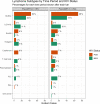Comparison of baseline lymphoma and HIV characteristics in Malawi before and after implementation of universal antiretroviral therapy
- PMID: 36048901
- PMCID: PMC9436050
- DOI: 10.1371/journal.pone.0273408
Comparison of baseline lymphoma and HIV characteristics in Malawi before and after implementation of universal antiretroviral therapy
Abstract
Access to antiretroviral therapy (ART) led to epidemiological changes in human immunodeficiency virus (HIV) associated lymphoma in high-income countries such as reductions in diffuse large B-cell lymphoma (DLBCL) and stable or increased Hodgkin lymphoma (HL) and Burkitt lymphoma (BL). In 2016, Malawi implemented a universal ART (UART) policy, expanding ART eligibility to all persons living with HIV (PLWH). We compare the distribution of lymphoma subtypes and baseline HIV and prognostic characteristics for lymphoma patients in Malawi before and after implementation of UART. We enrolled patients with pathologically confirmed incident lymphoproliferative disorders into a observational clinical cohort. At diagnosis, a comprehensive clinicopathological evaluation was performed. Of 412 participants, 156 (38%) were pre-UART (2013-June 2016) and 256 (62%) post-UART (July 2016-2020). HIV prevalence was 50% in both groups. The most common pre-UART diagnoses were DLBCL [75 (48%)], low-grade non-Hodgkin lymphoma (NHL) [19 (12%)], HL [17 (11%)] and, BL [13 (8%)]. For post-UART they were DLBCL [111 (43%)], NHL [28 (11%)], BL [27 11%)] and, HL [20 (8%)]. Among PLWH, 44 (57%) pre-UART initiated ART prior to lymphoma diagnosis compared to 99 (78%) post-UART (p = 0.02). HIV-ribonucleic acid was suppressed <1000 copies/mL in 56% (33/59) pre-UART and 71% (73/103) post-UART (p = 0.05). CD4 T-cell counts were similar for both groups. We observed similar findings in the subset of participants with DLBCL. Overall, there were no significant changes in incident lymphoma subtypes (p = 0.61) after implementation of UART, but HIV was better controlled. Emerging trends bear monitoring and may have implications for prognosis and health system priority setting. Trial registration: ClinicalTrials.gov identifier: NCT02835911.
Conflict of interest statement
No commercial support was provided for this study. This work was completed while Dr. Satish Gopal was employed at the University of North Carolina at Chapel Hill. The opinions expressed in this article are the authors own and do not reflect the view of the National Institutes of Health, the Department of Health and Human Services, or the United States Government.
Figures

Similar articles
-
Short communication: spectrum of non-Hodgkin lymphoma in an urban Ryan White-funded clinic in the established antiretroviral era.AIDS Res Hum Retroviruses. 2014 Jul;30(7):665-9. doi: 10.1089/AID.2013.0188. Epub 2014 Jun 3. AIDS Res Hum Retroviruses. 2014. PMID: 24707838
-
Temporal trends in presentation and survival for HIV-associated lymphoma in the antiretroviral therapy era.J Natl Cancer Inst. 2013 Aug 21;105(16):1221-9. doi: 10.1093/jnci/djt158. Epub 2013 Jul 26. J Natl Cancer Inst. 2013. PMID: 23892362 Free PMC article.
-
Complete response to front-line therapies is associated with long-term survival in HIV-related lymphomas in Taiwan.J Microbiol Immunol Infect. 2024 Jun;57(3):426-436. doi: 10.1016/j.jmii.2024.04.001. Epub 2024 Apr 6. J Microbiol Immunol Infect. 2024. PMID: 38632022
-
[Human immunodeficiency virus and lymphoma].Bull Cancer. 2021 Oct;108(10):953-962. doi: 10.1016/j.bulcan.2021.03.014. Epub 2021 Jul 8. Bull Cancer. 2021. PMID: 34246454 Review. French.
-
The Changing Landscape of Lymphoma Associated with HIV Infection.Curr Oncol Rep. 2020 Aug 15;22(11):111. doi: 10.1007/s11912-020-00973-0. Curr Oncol Rep. 2020. PMID: 32803474 Free PMC article. Review.
Cited by
-
HIV and prior exposure to antiretroviral therapy alter tumour composition and tumour: T-cell associations in diffuse large B-cell lymphoma.Br J Haematol. 2024 Jul;205(1):194-206. doi: 10.1111/bjh.19531. Epub 2024 May 20. Br J Haematol. 2024. PMID: 38769021 Free PMC article.
-
Shared genomic features of HIV+ diffuse large B-cell lymphoma in two African cohorts.Sci Rep. 2025 Jul 9;15(1):24599. doi: 10.1038/s41598-025-10529-6. Sci Rep. 2025. PMID: 40634688 Free PMC article.
-
HIV infection and ART exposure affect tumor TCR repertoire of diffuse large B cell lymphoma.JCI Insight. 2024 May 23;9(13):e180771. doi: 10.1172/jci.insight.180771. JCI Insight. 2024. PMID: 38781015 Free PMC article.
-
Lymphoma in Sub-Saharan Africa: a scoping review of the epidemiology, treatment challenges, and patient pathways.Cancer Causes Control. 2025 Mar;36(3):199-230. doi: 10.1007/s10552-024-01922-z. Epub 2024 Oct 17. Cancer Causes Control. 2025. PMID: 39417984 Free PMC article.
References
-
- Bray F, Ferlay J, Soerjomataram I, Siegel RL, Torre LA, Jemal A. Global cancer statistics 2018: GLOBOCAN estimates of incidence and mortality worldwide for 36 cancers in 185 countries. CA: A Cancer Journal for Clinicians. 2018;68(6):394–424. - PubMed
Publication types
MeSH terms
Substances
Associated data
Grants and funding
LinkOut - more resources
Full Text Sources
Medical
Research Materials

